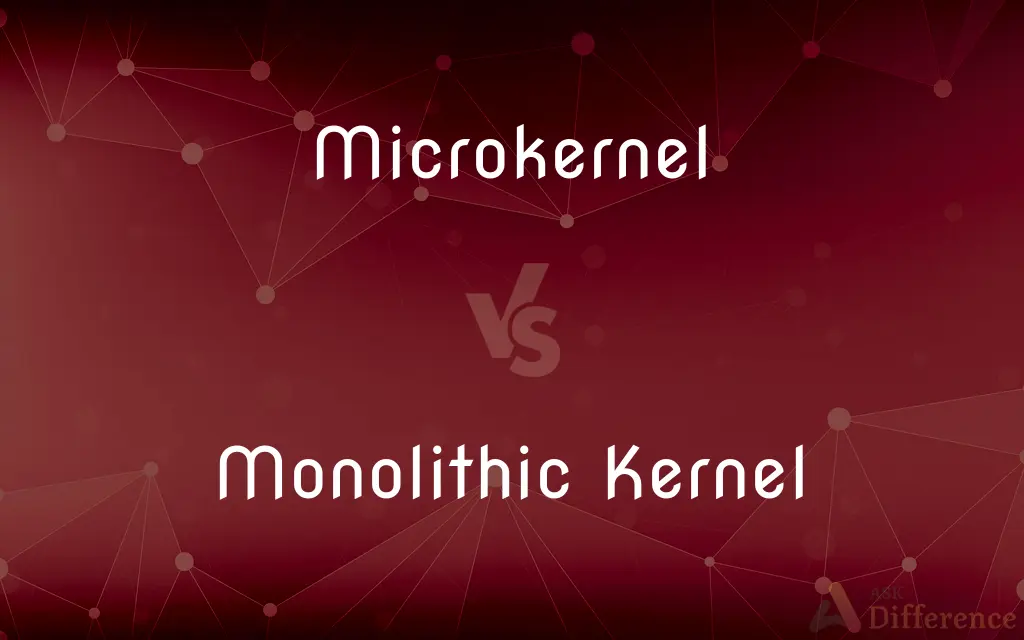Microkernel vs. Monolithic Kernel — What's the Difference?
By Tayyaba Rehman — Published on January 4, 2024
Microkernel is an operating system design where core functions are kept minimal, and additional services run as separate user processes. Monolithic Kernel, on the other hand, integrates all system functions into a single, large kernel.

Difference Between Microkernel and Monolithic Kernel
Table of Contents
ADVERTISEMENT
Key Differences
In a Microkernel architecture, the kernel provides only essential functions like memory management, process scheduling, and inter-process communication. Additional services, such as file systems and device drivers, run as separate user-level processes. This design promotes modularity, flexibility, and easier maintenance. However, it can introduce some performance overhead due to inter-process communication.
A Monolithic Kernel combines all operating system functions, including device drivers and file systems, into a single, large kernel. This design aims for maximum performance but can result in reduced modularity and increased complexity. Any kernel update or addition of new features may require modifying the entire kernel, making maintenance more challenging.
Comparison Chart
Modularity
Highly modular with separate user processes
Less modular with tightly integrated functions
Maintenance
Easier to maintain and update
Complex maintenance due to kernel size
Performance
May introduce some overhead
Typically offers higher performance
ADVERTISEMENT
Security
Potential for enhanced security
Security may be compromised if one component fails
Examples
MINIX, QNX
Linux, Unix, Windows NT
Compare with Definitions
Microkernel
The Microkernel architecture separates kernel components into independent modules for increased modularity and flexibility.
Microkernels promote software modularity and easier maintenance.
Monolithic Kernel
A Monolithic Kernel is an operating system design where all system functions, including device drivers and file systems, are tightly integrated into a single kernel.
Linux is one of the most popular Monolithic Kernel-based operating systems.
Microkernel
A Microkernel is an operating system design that maintains core kernel functions at a minimum, with additional services running as separate user-level processes.
MINIX is an example of a Microkernel-based operating system.
Monolithic Kernel
In a Monolithic Kernel, system calls and services are part of the same kernel image for improved performance.
The Monolithic Kernel approach aims for maximum execution speed.
Microkernel
In a Microkernel-based OS, device drivers and file systems operate as user-level processes rather than part of the kernel.
The Microkernel approach simplifies adding new device drivers.
Monolithic Kernel
The Monolithic Kernel architecture prioritizes system performance but may lack the modularity of Microkernel designs.
Unix operating systems often employ a Monolithic Kernel.
Microkernel
Microkernels facilitate fault isolation, as a failure in one component doesn't necessarily affect the entire system.
The Microkernel's design enhances the system's resilience to faults.
Monolithic Kernel
Monolithic Kernels are known for their efficiency in executing system calls and managing hardware resources.
Windows NT is built on a Monolithic Kernel architecture.
Microkernel
Microkernel-based systems focus on minimizing the kernel size to provide only essential functions.
QNX is known for its efficient Microkernel architecture.
Monolithic Kernel
Kernel updates or additions to system features may require modifying the entire Monolithic Kernel.
Maintaining a Monolithic Kernel can be complex due to its size and interdependencies.
Microkernel
(operating systems) A minimal operating system kernel offering basic mechanisms rather than abstract services.
Common Curiosities
What is the key difference between a Microkernel and a Monolithic Kernel?
The key difference lies in their architecture. A Microkernel keeps core functions minimal, while a Monolithic Kernel integrates all system functions into a single, large kernel.
In terms of performance, which kernel architecture typically offers higher speed?
Monolithic Kernels are known for offering higher performance due to their tightly integrated design.
Which kernel design prioritizes modularity and easier maintenance?
The Microkernel design prioritizes modularity and easier maintenance by separating additional services into user-level processes.
Name an example of an operating system that uses a Monolithic Kernel.
Linux is a prominent example of an operating system that employs a Monolithic Kernel architecture.
What is the advantage of a Microkernel in terms of security?
A Microkernel architecture can enhance security as a failure in one component doesn't necessarily compromise the entire system's security.
Which operating system is recognized for its efficient Microkernel architecture?
QNX is known for its efficient Microkernel architecture.
Which kernel design philosophy minimizes the size of the kernel to provide only essential functions?
Microkernel design philosophy focuses on minimizing the kernel size to provide only essential functions.
Which type of kernel design promotes software modularity and easier maintenance?
Microkernel designs promote software modularity and easier maintenance by separating kernel components.
What is the main drawback of Monolithic Kernel maintenance?
Maintaining a Monolithic Kernel can be complex due to its size and interdependencies, making updates and additions challenging.
Which kernel architecture is suitable for systems where performance is a top priority?
Monolithic Kernels are suitable for systems where performance is a top priority.
What is the primary advantage of Monolithic Kernels in terms of execution speed?
Monolithic Kernels prioritize maximum execution speed due to their tightly integrated design.
Which kernel architecture is more efficient in executing system calls and managing hardware resources?
Monolithic Kernels are known for their efficiency in executing system calls and managing hardware resources.
How does a Microkernel architecture enhance fault tolerance?
In a Microkernel-based system, a failure in one component doesn't necessarily affect the entire system, enhancing fault tolerance.
In a Microkernel-based OS, where do device drivers and file systems operate?
In a Microkernel-based OS, device drivers and file systems operate as user-level processes rather than part of the kernel.
Which type of kernel architecture is widely used in Unix operating systems?
Unix operating systems often employ a Monolithic Kernel architecture.
Share Your Discovery

Previous Comparison
For Loop vs. While Loop
Next Comparison
Procedural Knowledge vs. Declarative KnowledgeAuthor Spotlight
Written by
Tayyaba RehmanTayyaba Rehman is a distinguished writer, currently serving as a primary contributor to askdifference.com. As a researcher in semantics and etymology, Tayyaba's passion for the complexity of languages and their distinctions has found a perfect home on the platform. Tayyaba delves into the intricacies of language, distinguishing between commonly confused words and phrases, thereby providing clarity for readers worldwide.
















































